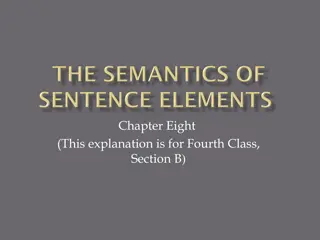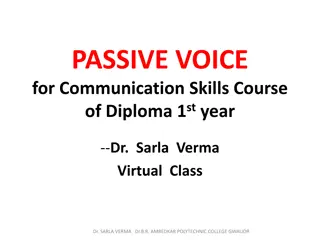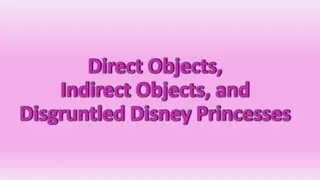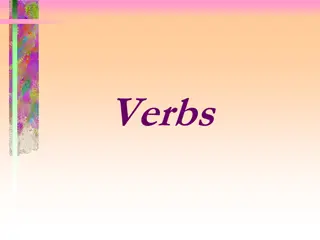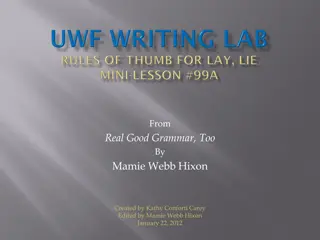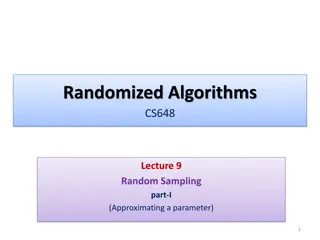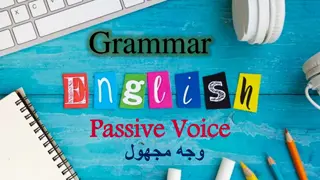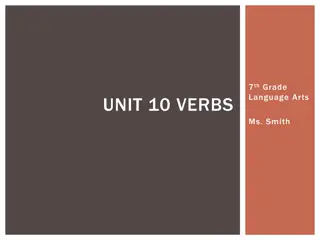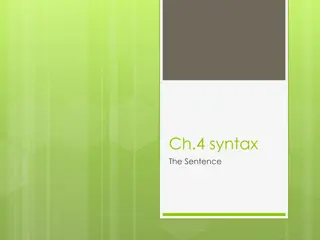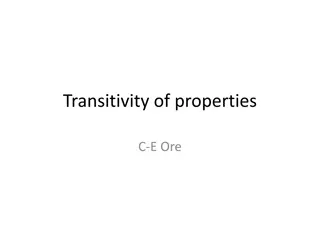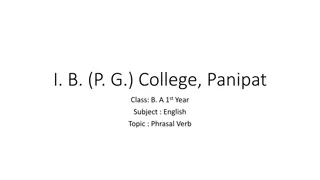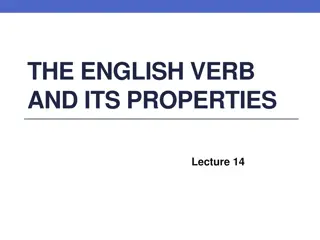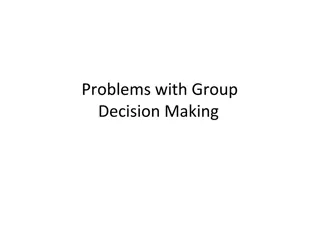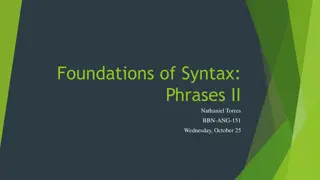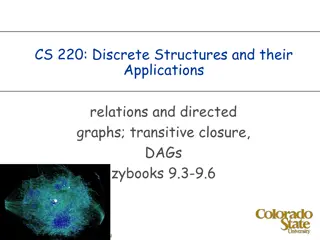JENIS-JENIS RELASI
Exploring various types of relations in mathematics such as reflexive, symmetric, transitive, and equivalence relations with examples. Understand the definitions and properties of each type to enhance your comprehension of mathematical concepts.
2 views • 10 slides
Understanding Semantic Roles in Sentence Structure
Semanticists analyze sentences based on semantic structure rather than traditional syntactic terms like subject and object. Instead, they use semantic terms such as Agent, External causer, Instrument, Affected, Recipient, and Locative. These terms help describe how people and things participate in r
1 views • 26 slides
Understanding Active and Passive Voice for Better Communication Skills
This content covers essential aspects of active and passive voice in communication skills. It explains the difference between the two voices, provides examples, and clarifies when to use passive voice. The importance of transitive verbs in forming passive sentences is highlighted along with intransi
3 views • 29 slides
Understanding Verb Forms: Lie/Lay, Sit/Set, Rise/Raise
Learn about the correct usage of transitive and intransitive verbs with examples of common verb pairs like lie/lay, sit/set, and rise/raise. Understand the distinctions between these verb forms to improve your grammar skills and communication accuracy. Enhance your knowledge through this detailed le
0 views • 4 slides
Understanding Direct and Indirect Objects in Sentences
Learn about direct objects, indirect objects, and how they are used in sentences. Explore examples with Disney princesses like Snow White and Ariel to understand the concept better. Discover the difference between transitive and intransitive verbs and their usage in sentences.
0 views • 10 slides
Understanding Verbs: Parts, Functions, and Classification
Delve into the intricate world of verbs and uncover their diverse aspects such as principal parts, functions in grammar, and classification as transitive or intransitive. Explore how verbs express action, state of being, or linkage, forming the foundation of language structure.
0 views • 41 slides
Understanding the Difference Between Lay and Lie Verbs in English Grammar
Learn the distinction between the transitive verb "lay" and the intransitive verb "lie" in English grammar, along with their principal parts and usage examples. Avoid confusion by understanding when to use "lay" and "lie" correctly in different contexts.
0 views • 21 slides
Randomized Algorithms for Approximating Parameters
Lecture 9 of CS648 covers the random sampling approach for estimating parameters, such as determining the number of balls in a bag and the size of the transitive closure of a directed graph. An inspirational problem from continuous probability theory is discussed, involving selecting points uniforml
0 views • 38 slides
Understanding Passive Voice in English Grammar
This content covers the concept of passive voice in English grammar, providing examples and explanations of how to form passive voice sentences. It includes information on intransitive and transitive verbs, transforming active voice to passive voice, and common passive voice structures. Visual aids
0 views • 16 slides
Understanding Graph Data Structures and Algorithms by Ali Akbar Mohammadi
This content delves into the foundational concepts of graph data structures, covering topics such as graph traversal, transitive closure, minimum spanning trees, and more. Ali Akbar Mohammadi provides insight into the world of graphs, emphasizing the importance of vertices, edges, and the relationsh
0 views • 19 slides
Understanding Verbs in 7th Grade Language Arts with Ms. Smith
Learn about action verbs, transitive and intransitive verbs, verbs with indirect objects, linking verbs, predicate verbs, and tenses in Unit 10 with Ms. Smith. Explore examples and explanations to enhance your verb knowledge and language skills.
0 views • 8 slides
Understanding Sentence Patterns in English Grammar
Explore the basics of sentence structure in English grammar, including complete and incomplete sentences, sentence patterns like Subject-Verb (S+V) and Subject-Verb-Object (SVO), the concept of direct objects, and the difference between transitive and intransitive verbs. Enhance your knowledge with
0 views • 32 slides
Understanding Verbs: Types and Forms in English Grammar
Verbs in English grammar play a crucial role in expressing actions and states. They can be classified into various types such as action verbs, linking verbs, main verbs, auxiliary verbs, transitive verbs, intransitive verbs, and phrasal verbs. Verbs have six forms including base form, infinitive, pa
0 views • 13 slides
Understanding Sentence Structure in English Language
Explore the elements of simple and complex sentences, types of verbs, examples of transitive and intransitive verbs, different object types, and the role of complements in English sentences. Enhance your knowledge of syntax and sentence construction.
0 views • 22 slides
Understanding Transitivity of Properties in Typed Systems
Exploring the concept of transitivity in properties within a typed system, this content delves into explicit and possibly transitive properties, showcasing how properties relate to each other and how they can be implicitly or explicitly defined. Through examples and explanations, the content provide
0 views • 18 slides
Understanding Phrasal Verbs in English
A phrasal verb is a combination of a verb and a preposition/adverb that forms an idiomatic expression with unique meanings. They can be intransitive or transitive, and the position of the object in phrasal verbs varies. Learn about the different types of phrasal verbs and how they are used in senten
0 views • 9 slides
Understanding Properties of the English Verb
The English verb plays a central role in expressing predicative functions in sentences, connecting the situation with reality. It encompasses finite and non-finite forms, such as simple, expanded, stress-replacive, and phrasal verbs. Verbs are categorized as notional or functional, actional or stata
0 views • 19 slides
Total Order Approach for Reachability Queries in Dynamic Graphs
Explore a total order approach for reachability queries in large dynamic graphs, discussing existing solutions for static graphs and dynamic updates. The Total Order Labeling framework and Butterfly update algorithms are presented as key contributions, focusing on scalability and transitive closure
1 views • 42 slides
A New Combinatorial Gray Code for Balanced Combinations
This research work by Torsten Mütze, Christoph Standke, and Veit Wiechert introduces a new combinatorial Gray code for balanced combinations, focusing on a-element subsets and flaws in Dyck path representation. The study explores various aspects of balanced combinations, their flaws, and the relati
0 views • 30 slides
Challenges in Group Decision Making and Democratic Systems
Challenges in group decision making within democratic systems are explored, with a focus on the two ways of evaluating political systems. While democracy is perceived as fair due to majority rule, social choice theory reveals complexities and paradoxes in aggregating individual preferences. The conc
0 views • 95 slides
Understanding Verb Phrases in Syntax
In this study, we delve into the intricacies of verb phrases within the realm of syntax. Starting with the basic structure of the Verb Phrase (VP), we explore intransitive and transitive verbs, their expansion with adverbs, prepositional phrases, and direct objects. By analyzing examples and discuss
0 views • 23 slides
Understanding Directed Graphs and Adjacency Matrices in Discrete Structures
Explore the concepts of binary relations, directed graphs, adjacency matrices, transitive closure, and walks in the context of discrete structures. Learn how vertices, edges, in-degrees, out-degrees, and self-loops are defined in directed graphs. Understand the importance of adjacency matrices in re
0 views • 28 slides

